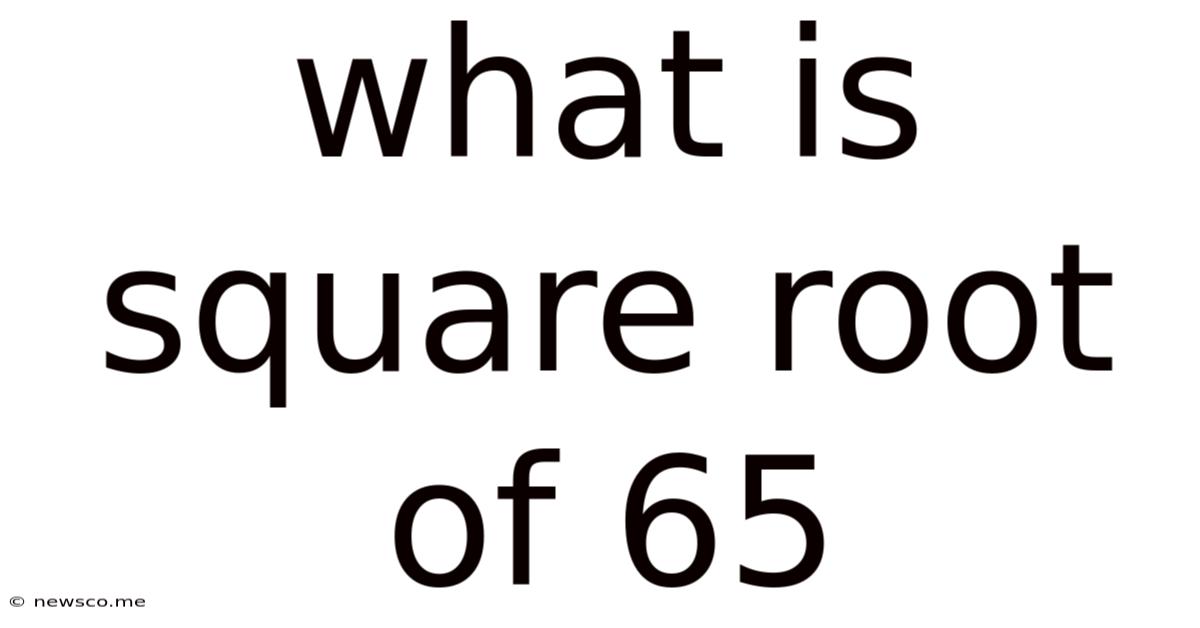What Is Square Root Of 65
News Co
Mar 26, 2025 · 4 min read

Table of Contents
What is the Square Root of 65? A Deep Dive into Irrational Numbers and Approximation Methods
The question, "What is the square root of 65?" might seem simple at first glance. However, delving into the answer reveals fascinating insights into the world of mathematics, specifically the realm of irrational numbers and the various methods employed to approximate their values. This article will explore the nature of the square root of 65, its properties, and several techniques for calculating its approximate value, catering to both beginners and those seeking a deeper understanding.
Understanding Square Roots
Before we tackle the square root of 65, let's establish a foundational understanding of what a square root represents. The square root of a number 'x' is a value that, when multiplied by itself, equals 'x'. In mathematical notation, this is expressed as √x. For example, the square root of 9 (√9) is 3 because 3 * 3 = 9.
This concept seems straightforward for perfect squares – numbers that have whole number square roots (like 4, 9, 16, 25, etc.). However, things get more interesting when we encounter numbers like 65, which is not a perfect square.
The Irrational Nature of √65
The square root of 65 (√65) is an irrational number. This means it cannot be expressed as a simple fraction (a ratio of two integers). Its decimal representation is non-terminating and non-repeating, meaning it goes on forever without ever settling into a repeating pattern. This is a fundamental characteristic of many square roots of non-perfect squares. Trying to write it out completely is impossible; we can only approximate its value.
This irrationality is a consequence of the number 65 not being a perfect square. If we attempt to factorize 65, we get 5 x 13. Both 5 and 13 are prime numbers, meaning they are only divisible by 1 and themselves. The lack of repeated prime factors prevents √65 from simplifying to a rational number.
Methods for Approximating √65
Since we cannot express √65 exactly, we resort to approximation methods. Here are a few approaches, ranging from simple estimation to more sophisticated algorithms:
1. Estimation through Perfect Squares
The simplest method involves using nearby perfect squares. We know that 8² = 64 and 9² = 81. Since 65 lies between 64 and 81, we can deduce that √65 lies between 8 and 9. This provides a rough estimate, but it lacks precision.
2. Babylonian Method (or Heron's Method)
This iterative method provides increasingly accurate approximations. It's based on repeatedly refining an initial guess using the formula:
x_(n+1) = 0.5 * (x_n + S/x_n)
Where:
- x_n is the current approximation
- x_(n+1) is the next, improved approximation
- S is the number whose square root we are seeking (in this case, 65)
Let's illustrate this with an initial guess of 8:
- Iteration 1: x_1 = 0.5 * (8 + 65/8) ≈ 8.0625
- Iteration 2: x_2 = 0.5 * (8.0625 + 65/8.0625) ≈ 8.0622577
- Iteration 3: x_3 = 0.5 * (8.0622577 + 65/8.0622577) ≈ 8.0622577
As you can see, the approximation converges quickly. After just a few iterations, we get a very close approximation of √65.
3. Newton-Raphson Method
A more advanced iterative method, the Newton-Raphson method, also converges rapidly to the square root. It uses the formula:
x_(n+1) = x_n - (f(x_n) / f'(x_n))
Where:
- f(x) = x² - S (S is the number whose square root we're finding)
- f'(x) = 2x (the derivative of f(x))
This method requires a bit more calculus understanding but provides highly accurate results.
4. Using a Calculator or Computer Software
The most practical method for finding a highly precise approximation of √65 is using a calculator or computer software with a built-in square root function. These tools employ sophisticated algorithms to calculate the value to many decimal places.
Applications of √65
While seemingly abstract, the square root of 65, or approximations thereof, finds applications in various fields:
- Geometry: Calculating the length of the hypotenuse of a right-angled triangle where the other two sides have lengths related to 65.
- Physics: Solving equations involving distances, velocities, or other quantities that are squared.
- Engineering: Design calculations where square roots are involved.
- Computer graphics: Calculating distances and transformations in two- or three-dimensional space.
Conclusion
The square root of 65, while an irrational number with an infinite, non-repeating decimal representation, is not an insurmountable mathematical challenge. We've explored different methods, from simple estimation to iterative algorithms, showcasing how we can approach and approximate its value with varying degrees of accuracy. The choice of method often depends on the required precision and the available tools. Understanding the concept of irrational numbers and the various approximation techniques is crucial for anyone pursuing a deeper understanding of mathematics and its real-world applications. The seemingly simple question, "What is the square root of 65?" opens a door to a vast and fascinating field of mathematical exploration.
Latest Posts
Related Post
Thank you for visiting our website which covers about What Is Square Root Of 65 . We hope the information provided has been useful to you. Feel free to contact us if you have any questions or need further assistance. See you next time and don't miss to bookmark.